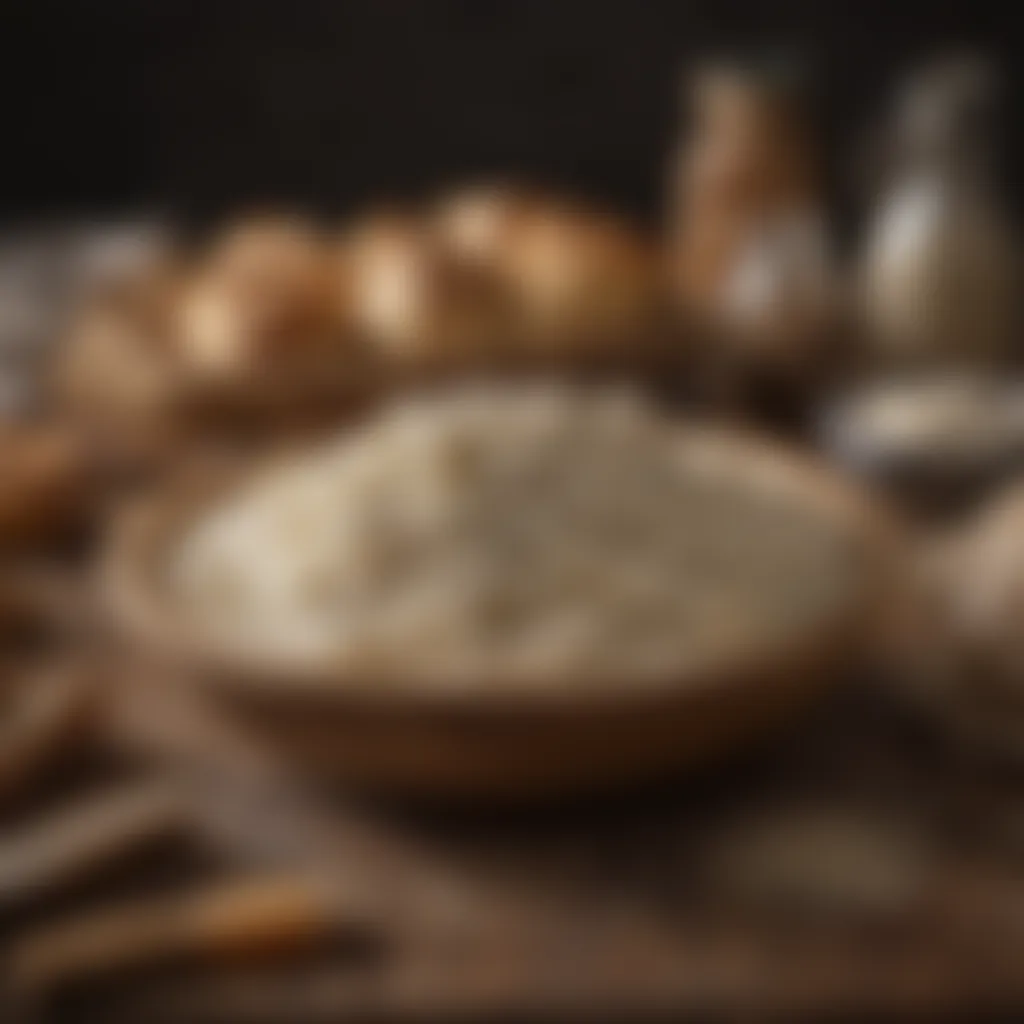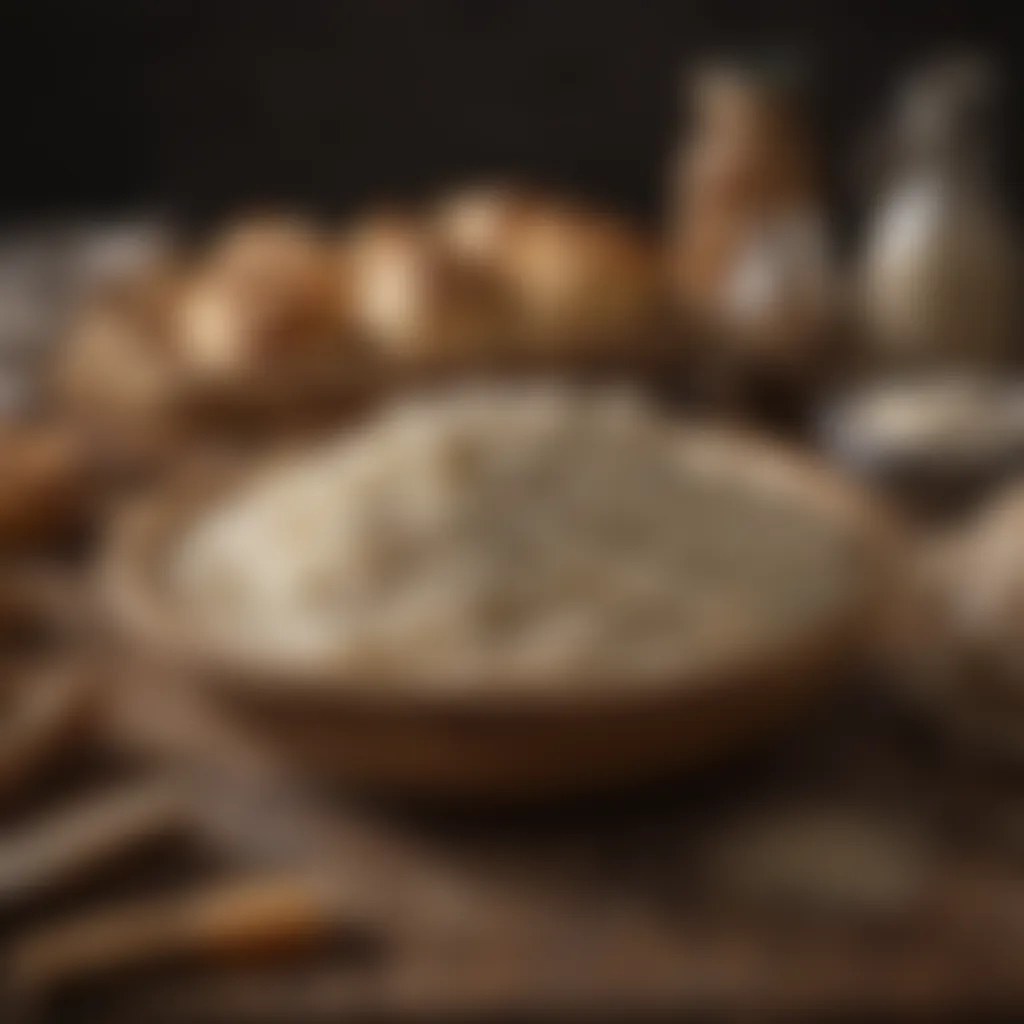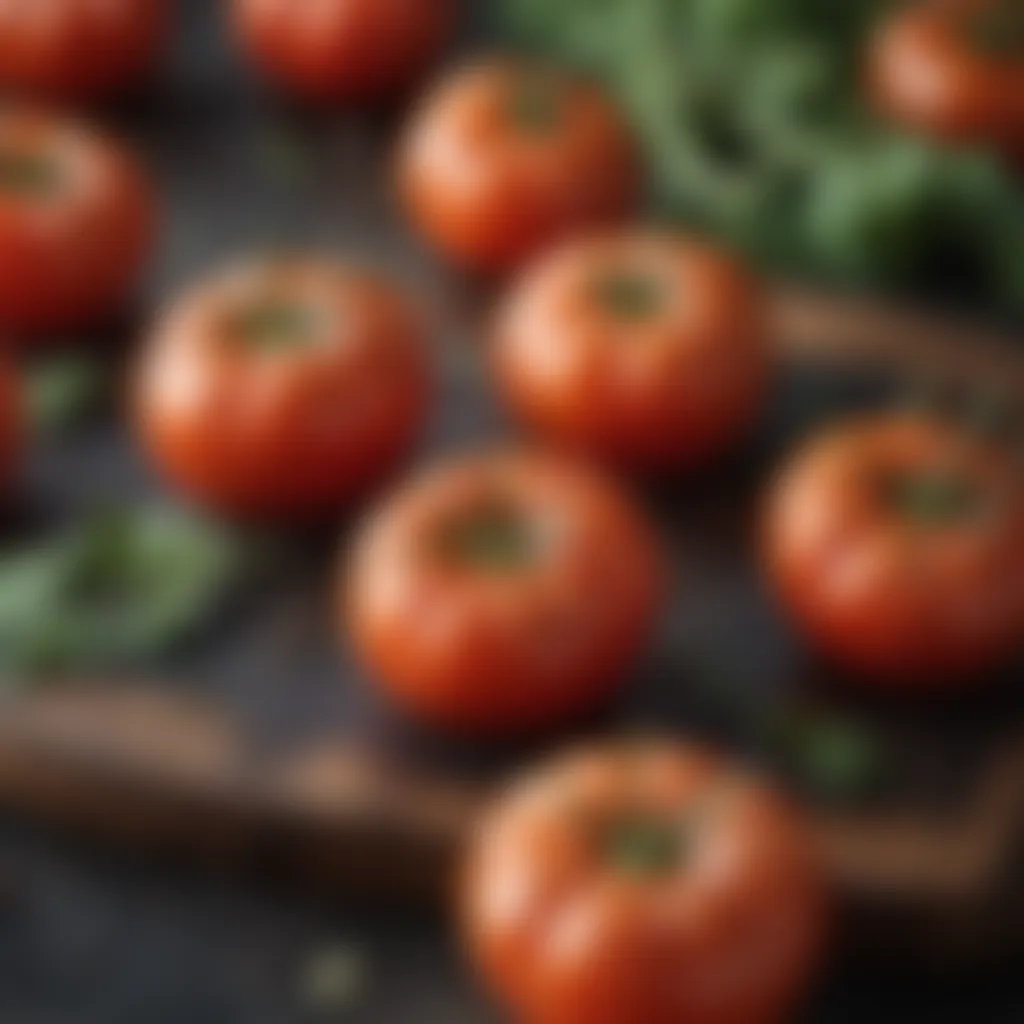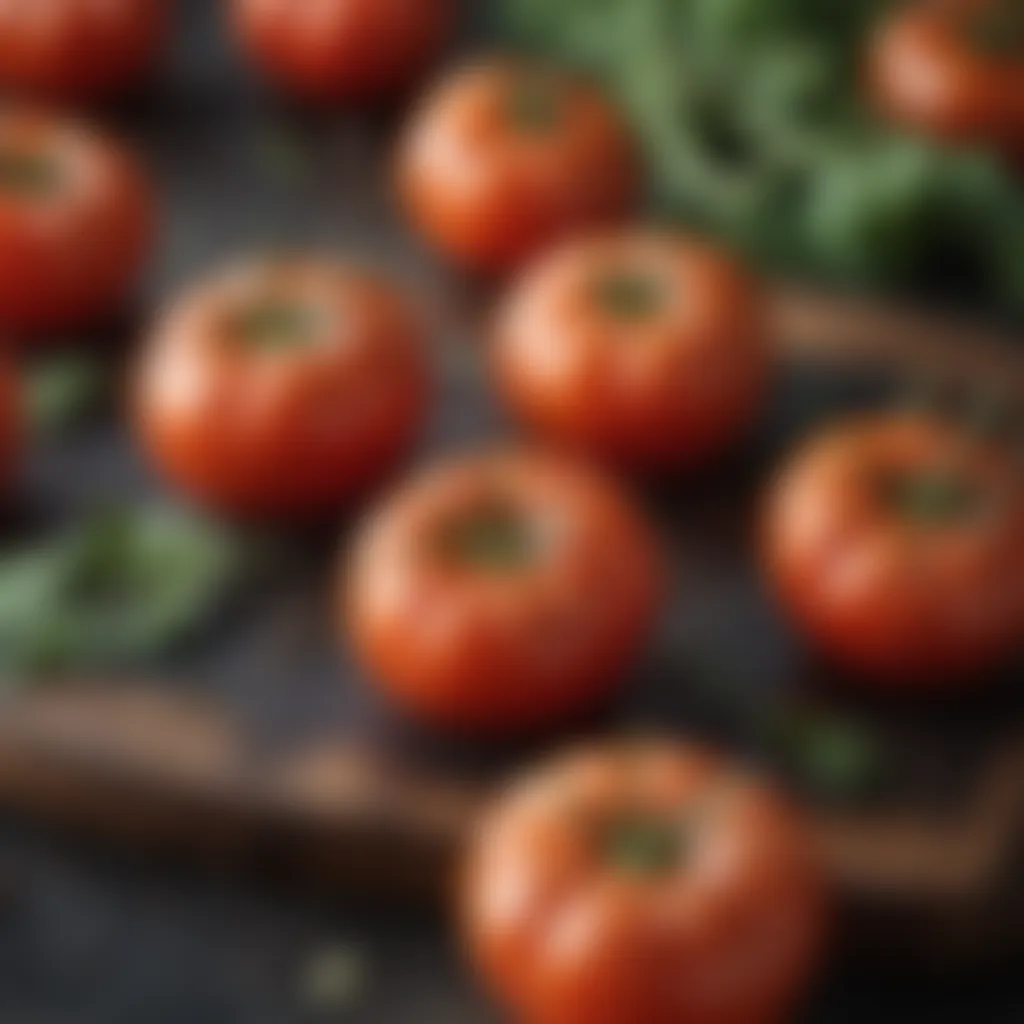Crafting Perfect Panini Bread: A Complete Guide


Intro
In the world of culinary delights, few creations can rival the satisfaction of biting into a perfectly crafted panini. The combination of crisp, golden-brown crust with a soft and flavorful interior is simply irresistible. But what's the secret behind this beloved sandwich? Is it all about the type of bread, the fillings, or the magic of grilling?
To make bakery-quality panini bread at home, one must not only gather the right ingredients but also understand the techniques and nuances that elevate this staple from ordinary to extraordinary. Let’s dive into the essentials that will guide you from the first measure of flour to the last bite of a delightful panini.
Ingredients:
Creating the base for your panini is straightforward, but the quality of your ingredients can really shine through. Here's everything you’ll need for that perfect loaf:
- Bread flour: 500 grams (about 4 cups)
- Active dry yeast: 10 grams (2 teaspoons)
- Warm water: 300 ml (1.25 cups) at about 110°F (43°C)
- Olive oil: 30 ml (2 tablespoons)
- Sugar: 10 grams (2 teaspoons)
- Salt: 10 grams (2 teaspoons)
- Optional: 1 tablespoon of dried herbs, such as oregano or basil for added flavor
Gathering these ingredients sets you on a path to creating a warm loaf that will hold your favorite fillings with grace.
Preparation Steps:
Now that you have your ingredients, follow this step-by-step guide to prepare your dough:
- Activate the Yeast: In a bowl, combine the warm water and sugar, sprinkle the yeast over the surface, and let it sit for 5 to 10 minutes until it becomes frothy. This ensures that your yeast is alive and kicking.
- Mix the Dry Ingredients: In a larger mixing bowl, combine the bread flour and salt (and any dried herbs if you opted for them). Mix them well with a whisk.
- Combine: Once the yeast is activated, pour it into the dry mixture along with the olive oil. Stir with a wooden spoon until a shaggy dough forms.
- Knead the Dough: Transfer the dough onto a lightly floured surface. Knead it for about 10 minutes until it becomes smooth and elastic. This step is crucial for developing the gluten structure necessary for a good rise.
- First Proofing: Place the dough in a lightly oiled bowl, cover it with a damp cloth, or use plastic wrap. Let it rise in a warm place for about 1 to 1.5 hours, or until it doubles in size.
Technical Aspects:
To achieve the right texture and flavor, paying attention to temperature and timing is essential:
- Room Temperature: Make sure that your kneading area is warm. Yeast thrives in warmth.
- Proofing Environment: An oven with the light on or a slightly heated area can create an ideal environment for proofing.
- Timing Matters: Don't rush the proving stages; patience is key as this is where the magic happens.
Cooking Process:
Once your dough has risen beautifully, it’s time to shape and bake:
- Shape the Dough: Punch down the risen dough to release excess air. Divide it into smaller portions (about 200 grams each) to form individual panini rolls.
- Second Proofing: Shape each portion into a ball and let them rest on a floured surface for an additional 30 minutes.
- Prepare the Oven: Preheat your oven to 450°F (232°C). If you have a baking stone or a baking sheet, place it in the oven to heat up.
- Roll Out: Once rested, flatten each ball of dough with a rolling pin, aiming for a thickness of about half an inch.
- Bake: Transfer the shaped dough onto the preheated baking stone or sheet, and bake for 15 to 20 minutes until they’re golden brown.
Troubleshooting Tips:
Even the best bakers face hurdles. Here’s how to address common mishaps:
- Dough Not Rising: Ensure your yeast is fresh. Too hot or too cold water can kill yeast. Aim for a warm, but not scalding, temperature.
- Dense Bread: This could be a sign of under-kneading or too much flour. Aim for a smooth, slightly tacky dough.
- Stale Bread: If not consumed immediately, store your bread in a paper bag to retain freshness.
Remember, practice makes perfect! Even if your first loaf isn’t bakery-quality, every attempt brings you closer to mastering the art of panini bread-making.
Understanding Panini Bread
Understanding what makes panini bread special goes beyond merely listing its ingredients. Panini bread serves as the foundation of countless culinary creations, acting as a canvas upon which flavors mingle and delight the senses. Realizing this importance empowers bakers to appreciate both the art and science behind each loaf—not just in the baking process, but also in the joy of creation and consumption.
When you dive into making panini bread, it allows you to connect with the rich traditions of Italian cuisine, paying homage to its roots while infusing your own creativity. The ability to make your own bread translates to something more heartwarming than a store-bought loaf. It’s a pursuit that celebrates craftsmanship, encourages experimentation, and promotes a sense of pride in your cooking talents. Besides, can one resist the allure of the crusty exterior and soft, chewy inside?
The Origins of Panini
Panini, often associated with pressed sandwiches, shimmer with an intriguing history. These delectable creations originated in Italy, where bread was a dietary staple long before anyone thought to grill it. The name "panini" itself derives from the Italian word for "small breads," referring to any kind of bread one might use for sandwiches. While you might think of a panini as something modern, its roots reach deep into Italian culture, where locals have long enjoyed filling bread with meats, cheeses, and vegetables.
Though the term itself became popularized in the United States during the late 20th century, the practice of creating hearty sandwiches from crusty baguette-like breads has existed for ages. Traditionalists often favor ciabatta or focaccia for their unique ability to hold fillings while remaining both flavorful and comforting. Local variations across Italy also showcase how this simple concept blossomed into an array of delightful adaptations.
Characteristics of Quality Panini Bread
Creating the perfect panini requires an understanding of what signifies quality bread. Not all bread is equal, especially when it comes to making panini. Here are a few key characteristics to keep in mind:
- Crustiness: A good loaf should have a crust that is crispy upon baking. It acts as a barrier, holding in moisture while allowing the fillings to shine.
- Chewiness: The inside should be soft yet slightly chewy. This texture stands up to pressing, creating the delightful experience of biting into a well-made panini.
- Flavor: Quality panini bread must carry a rich flavor. Artisan breads often tap into the nuances of fermentation, which deepens the taste of the final product.
- Freshness: There's nothing quite like the smell of freshly baked bread wafting through your kitchen. Freshness ensures not only better flavor but also leads to an optimal sandwich experience.
Understanding these characteristics provides a solid foundation for any home baker, guiding them to mimic the artistry of skilled bakers.
In summary, grasping the fundamental elements of panini bread—its origins, essential traits, and cultural significance—helps inspire confidence as you embark on your baking journey. More than just an endeavor to make a delectable sandwich, it represents a fulfilling exploration into the realms of flavor, history, and personal culinary development.
Essential Ingredients
When it comes to crafting exquisite panini bread, the ingredients are the foundation of your masterpiece. Each element plays a pivotal role in ensuring the bread rises perfectly, has the right texture, and delights the palate. Understanding these ingredients can be the difference between an everyday loaf and one that rivals those found in the finest bakeries. In this section, we'll explore the core components that will set your panini apart.
Choosing the Right Flour
Flour is the star of the show in any bread recipe, including panini. Not all flours are created equal—each type brings its unique properties to the table.
For panini, a high-protein flour, such as bread flour, is often the best choice. Why? High-protein flour allows the dough to develop stronger gluten networks, resulting in a chewier texture and better rise. While all-purpose flour can also be used, it might yield a softer loaf that lacks the characteristic crust we associate with panini.
When selecting flour, pay attention to the brand. Some flours have been aged to develop flavor, while others might be bleached. Opt for unbleached flour when possible, as it retains more natural flavor, giving your bread a richer taste.
"The flour you choose can make or break your bread—select wisely and embrace the nuances it offers."
Importance of Yeast
Yeast is the magical ingredient that brings life to your dough. It ferments the sugars in the flour, producing carbon dioxide gas that causes the dough to expand. Without yeast, you’d essentially have a dense brick rather than fluffy, airy bread.
There are two primary types of yeast to consider: active dry yeast and instant yeast. Both are effective, but instant yeast doesn’t require proofing, which can be a time-saver. This makes it particularly appealing for busy home bakers. When using yeast, always check the expiration date; expired yeast may lead to a disappointing rise.
In addition to providing leavening, yeast contributes to the flavor profile of your bread. More fermentation time leads to complex flavors, so consider allowing your dough to rise slowly in the refrigerator overnight.


Role of Water and Salt
Water is often overlooked, yet its quality can impact the dough's hydration level. Using filtered or bottled water can be beneficial if your tap water is heavily chlorinated. Water impacts how your flour absorbs and interacts, which in turn affects the dough's consistency.
Salt serves several critical functions in bread-making: it enhances flavor, controls yeast activity, and strengthens gluten formation. Adding just the right amount helps you avoid a bland loaf and ensures that your yeast behaves as it should. A general rule of thumb is to use 1.5-2% salt based on the flour weight. Don’t skimp, thinking less will still taste good; fresh bread without salt lacks depth.
When mixing your ingredients, dissolve the salt in the water before combining it with the flour; this prevents the salt from directly hindering the yeast's growth too early.
In summary, understanding and choosing your essential ingredients carefully will set you on the path to creating outstanding panini bread. The next steps of the bread-making process will build on this solid foundation, leading you to bakeries-worthy results.
The Bread-Making Process
The process of bread-making is the heart and soul of crafting the perfect panini bread. It's not just about throwing some ingredients in a bowl and kneading away; it’s where science and art come together. Understanding this process equips you with the knowledge to troubleshoot issues that may arise and to appreciate the transformation of simple ingredients into a beautiful loaf. The various stages of this journey—from mixing to rising—each have their unique importance and can decisively affect the final outcome.
Mixing the Dough
Mixing the dough is where the magic begins. At this stage, you’re combining flour, yeast, water, and salt, creating a lump that seems uninviting at first glance. However, the importance of this step shouldn’t be underestimated. Proper mixing ensures that the yeast becomes evenly distributed throughout the dough, setting the stage for proper fermentation later on. If done correctly, you'll have a smooth, cohesive dough that will rise beautifully.
It’s key to mix until you see that the ingredients are fully incorporated, yet you don’t overdo it—the flour should not be overworked prematurely. Remember: consistency matters!
Kneading Techniques
Kneading is crucial as it develops the gluten in the dough, which gives the bread its structure and texture. Let’s discuss two popular methods of kneading:
Using Your Hands
Kneading with your hands allows for a tactile experience that many bakers cherish. It offers you a connection to the dough, letting you feel how it responds. One important aspect is that you can easily tell when it’s ready by its smoothness and elasticity. This technique promotes a deeper understanding of the dough itself, which can be a rewarding experience.
The notable characteristic here is control. You can adjust the pressure and techniques in real-time based on how the dough feels, allowing a personalized touch. While it can be labor-intensive, this method fosters a deeper appreciation for the craft of bread-making, making it a favored choice for those who enjoy the process as much as the result.
Using a Mixer
On the flip side, using a mixer, especially with a dough hook, can save time and effort. Mixers ensure a thorough kneading process without too much physical strain. The key here is efficiency; it allows you to multitask and manage your time better.
Using a mixer is especially beneficial for those who may struggle with the physicality of hand kneading or for larger batches where manual labor becomes impractical. However, it’s crucial to monitor the dough closely, as it can easily become over-kneaded, leading to a dense bread. Be sure to keep an eye on both the mixer speed and the dough’s texture.
Fermentation and Rising
Fermentation is not merely a step; it’s a transformation. This process is when yeast consumes sugars and emits carbon dioxide, which causes the dough to rise. During this phase, flavors develop, and textures change, leading to the airy, light quality that defines quality panini bread.
The timing of fermentation significantly affects the outcome. If rushed, the dough may not obtain the full flavor profile and texture. This is why many bakers recommend allowing for a slow rise in a cool environment, as it yields complexities in taste. Always keep an eye on your dough; it should roughly double in size, indicating it's ready for the next step.
"Patience is a virtue in bread-making. Rushing the process can leave you feeling flat, both in the dough and in spirit."
Shaping the Dough
Shaping the dough is like putting the cherry on top of a sundae. It’s where the magic meets the mechanics in the craft of panini bread-making. Effective shaping not only enhances the appearance of your loaf but also plays a critical role in its baking quality and texture. Having well-shaped dough leads to better gas retention during fermentation, which is crucial for achieving a fluffy crumb and a crisp crust. With that said, let's dive deeper into how to get it just right.
Dividing the Dough
Once your dough is well-proven, it's time to take the plunge into dividing it. This step is essential for creating uniform pieces that will rise and bake evenly, ensuring consistency in your final product. Here's how to do it:
- Flour your surface lightly to prevent sticking.
- Use a dough scraper or a sharp knife to cut the dough into equal portions. Depending on your recipe's yield, you might want to make anywhere from two to six pieces.
- Keep in mind the weight of each piece; if you're aiming for sandwiches, smaller portions are ideal, while larger pieces are better for sharing.
"A well-divided dough is half baked in terms of evenness."
You might find it helpful to weigh each piece, especially if you're preparing for a gathering or want to have a consistent size. Dividing the dough during its resting period helps to maintain its structure, reducing the chance of overworking it when shaping.
Techniques for Shaping
Now that you've divided the dough, the next task is shaping it into the desired form. Depending on your goal, shaping techniques could vary:
- Pre-shaping: This is a simple first step. Gently fold the edges of your divided piece towards the center, creating a loose ball. Allow it to rest for about 15 to 20 minutes. This gives the gluten a chance to relax.
- Final shaping: After the resting period, it’s time to get serious. For traditional rolls, flatten the ball slightly and fold the edges towards the center. Roll it gently into a tight ball, making sure to contain the air inside. If you’re looking for a specific shape, like baguettes, elongate the dough gently, being mindful not to expel all the air.
Preparing for Baking
Once you've got your dough shaped, preparing it for the oven is your next mission. This involves two main steps: proving and scoring.
- Proving: Before sliding your loaves into the oven, allow them a final rise. This could take anywhere from 30 minutes to an hour, and it’s crucial for the development of flavors and textures. The dough should double in size.
- Scoring: Use a sharp blade to cut shallow slits on the top of your dough. This might sound trivial but scoring is an art. It not only serves as a vent for steam but also adds an aesthetic appeal. Think of it as giving your loaf a little personality.
- Baking environment: Preheat your oven properly; you'll want it hot and ready. Some bakers even place a pan with water at the bottom of the oven to create steam, enhancing your crust’s crunch.
By focusing on these steps and techniques during the shaping phase, you’ll set the stage for achieving that bakery-quality panini bread you’re aiming for. Shaping the dough is more than just a formality; it’s a fundamental part of creating loaves that are beautiful, tasty, and worthy of every bite.
Baking Techniques
Baking techniques are the backbone of creating that ideal panini bread in your own kitchen. It's amazing how a few critical choices can make the difference between a subpar loaf and one that brings the essence of a traditional bakery right to your table. Understanding the nuances of baking is essential for achieving that crunchy crust enveloping a soft, airy center, just like those you would find in a bustling Italian cafe.
Choosing the Right Oven
The type of oven you select can dramatically impact your baking results. Convection ovens, for instance, circulate hot air and lead to more even baking and browning. On the other hand, traditional ovens may require adjustments in your baking times or temperatures to get things just right.
- Consider oven placement: Placing your dough in the center ensures even heat distribution.
- Preheat properly: Always make sure your oven is fully preheated—not just warm but hot. A well-heated oven will provide that initial burst of heat necessary to create a lovely crust.
- Temperature control: If your oven has a tendency to run hot or cool, be sure to invest in an oven thermometer. Trust me, it saves headaches down the line.
A reliable oven can be the difference between masterpiece bread and a doughy disaster.


Determining Bake Times and Temperatures
Another critical aspect is figuring out the right bake times and temperatures. Most recipes suggest a range, which can be influenced by many factors, including the size of your loaves and the oven type. A common mistake is to set the temperature too high or too low, leading to uneven baking.
- Typical range: Generally, baking panini bread at around 400°F to 475°F (200°C to 245°C) is standard. The exact number depends on the oven and the type of pan used.
- Check for doneness: Use a digital thermometer to ensure the internal temperature of the bread reaches about 190°F (88°C). Alternatively, a hollow sound when tapped on the bottom is a classic sign that it's finished.
Creating Steam for Crustiness
Want that satisfying crust that crackles with each bite? It’s all about steam. Most bakers overlook this crucial step. A simple way to do this is to introduce moisture into your oven at the beginning of the baking process, encouraging a crunchy exterior while allowing the bread to rise beautifully.
- Method 1: Place a pan filled with hot water on the bottom rack during preheating. The steam created will work wonders.
- Method 2: Spritz the inside of the oven with water using a spray bottle right as you place your bread inside. Be cautious not to get too carried away though—and remember, too much moisture can lead to sogginess, which is no one’s cup of tea.
Incorporating these baking techniques into your routine can elevate your panini bread game from ordinary to extraordinary. Each element—from oven choice to steam creation—plays a vital role in achieving that sought-after texture and flavor. Master these, and you’ll be well on your way to creating bakery-quality delights at home.
Common Issues and Solutions
Baking panini bread may seem straightforward, but it comes with its fair share of challenges. Knowing how to tackle potential issues ensures you don’t end up with a disheartening batch. Addressing these common concerns not only saves your time and ingredients but also elevates your bread-making skills.
Dough Not Rising
One of the most frustrating problems you might face is a dough that refuses to rise. This can result from a variety of factors. First off, check your yeast. If it’s old or improperly stored, it may not activate, leaving your dough flat. Fresh yeast should bubble and froth when added to warm water with a bit of sugar. Ensure your water isn't too hot or cold—ideally, it should hover around 100-110°F (37-43°C).
Another factor could be the environment. Yeast thrives in a warm, draft-free place. If your kitchen is chilly, consider placing the dough in a more insulated area. Cover it with a damp cloth or plastic wrap to lock in warmth. If after all this it still doesn’t rise, you might have to blame over-kneading or too dense a dough. Adjusting the flour-to-water ratio can be a simple fix.
"Bread-making is as much an art as it is a science; understanding the nuances of your ingredients is the secret to success."
Dense or Tough Texture
Are you left with a loaf so dense that it feels like a cannonball? This issue often stems from insufficient kneading or too much flour. Kneading develops the gluten structure, providing the light and airy texture we associate with good bread. As a rule of thumb, aim for about 10 minutes of kneading by hand or 5-7 minutes using a mixer.
If your dough seems dry, it may have absorbed more flour than necessary. Flour can vary in moisture content, so adding a little more water might do wonders. Proper resting times during fermentation are also crucial; do not rush this stage. Give your dough the time it needs to relax and expand, or you’ll end up with a tough loaf.
Crust Too Hard or Too Soft
Finding the crust of your panini bread either like granite or painfully flimsy can be equally disheartening. A hard crust usually indicates a high baking temperature—essential for a good rise but detrimental if it's overdone. If this is the case, you can lower your oven temperature or shorten your baking time.
On the flip side, a crust that doesn’t develop well can be the result of inadequate steam in the baking process. Steam creates that desirable crispy exterior. You can introduce steam by placing a pan of water in the oven during the initial baking period. Preheating your baking stone or baking sheet also helps.
Ultimately, striking the right balance between temperature and moisture is essential for achieving that perfect crust.
Understanding these common issues not only helps in troubleshooting your baking but also builds your confidence in mastering the craft of panini bread-making.
Flavor Enhancements
Flavor enhancements play a pivotal role in crafting panini bread that not only pleases the palate but also elevates the entire sandwich experience. While the fundamental aspects of the bread are significant, it is the infusion of delightful flavors that truly distinguishes an average panini from a memorable one. Incorporating various ingredients can enhance taste profile, making the bread not just a vessel, but a star in its own right. This section delves into the nuances of adding flavors through herbs, spices, olives, and cheese, showcasing how these elements can transform your panini bread into something extraordinary.
Incorporating Herbs and Spices
Herbs and spices can breathe life into panini bread, offering it a character that resonates with various cuisines. Adding fresh or dried herbs like basil, oregano, or rosemary during the dough mixing process can infuse your bread with vibrant aromas and flavors. Here’s how to effectively incorporate herbs:
- Choosing the Right Herbs: Fresh basil pairs beautifully with a classic Italian panini, while rosemary can give a Mediterranean twist. Consider the overall profile of the sandwiches you’ll be making.
- Usage Quantity: Generally, a tablespoon or two of fresh herbs or a teaspoon of dried herbs per batch is a good place to start. However, don’t be shy to adjust as per your taste.
- Combining with Spices: A pinch of garlic powder or smoked paprika can add depth alongside herbs. Experimenting is key until you find a balance that sings.
Using herbs and spices enriches not just the flavor of the panini bread but also enhances its aromatic appeal, enticing everyone around to indulge.
Proper blending of these elements allows your bread to complement the fillings superbly. Remember, the goal is to create harmony between the bread and its contents, ensuring one does not overpower the other but instead works in unison.
Using Olives and Cheese
The addition of olives and cheese to panini bread dough takes it to another level, both in flavor and texture. They bring a savory richness that can turn ordinary bread into something delightful and irresistible. Here’s a closer look:
- Olives: Chopped olives such as Kalamata or green olives can bring a briny kick. When mixed into the dough, they create pockets of flavor. It's crucial to chop them finely to distribute the brininess evenly.
- Cheese: Incorporating cheese into the dough can add moisture and a delightful cheesiness that complements the fillings. Feta or Parmesan is great choices as they melt well and impart deep flavors.
- Balancing Act: Be mindful of the saltiness, especially with olives and certain cheeses. Adjust your salt in the recipe accordingly to maintain the right flavor balance.
By creatively adding these flavors, the panini bread becomes an integral part of the culinary experience rather than merely a component. It offers layers of taste that can amaze even the most discerning eaters.
In summary, flavor enhancements transform your panini bread from basic to extraordinary. By experimenting with herbs, spices, olives, and cheese, every loaf can tell a unique story—one that resonates with the rich tradition of baking while inviting modern tastes. Embrace the nuances and let your creativity lead you; you might just stumble upon a combination that constitutes the best panini bread you’ve ever tasted!
Serving Suggestions
When it comes to enjoying panini bread, the manner in which you serve it can make all the difference. Serving suggestions are not just an afterthought; they are the finishing touch to a culinary creation. A well-laid out platter can elevate the humble panini into a gastronomic experience. Consider how different ingredients and accompaniments interact, enhancing flavor profiles and overall satisfaction.
Pairing with Meats and Vegetables
Panini bread is incredibly versatile. It can be paired with a myriad of meats and vegetables to cater to diverse palates. For example, if you’re a fan of rich, savory flavors, try a combination of prosciutto and arugula. The saltiness of the meat balances beautifully with the peppery notes of the greens, creating a delightful burst of taste.
On the other hand, if you prefer a lighter fare, grilled vegetables like bell peppers, zucchini, or eggplant provides a refreshing contrast. You might also consider a hint of balsamic glaze drizzled on top to add sweetness and acidity.
- Meat Options:
- Vegetable Choices:
- Prosciutto
- Turkey breast
- Roast beef
- Grilled zucchini
- Spinach
- Sun-dried tomatoes
Combining proteins and veggies is where the magic happens; it creates balance and can elevate the dining experience beyond the ordinary.


Ideas for Spreads and Sauces
The right spread or sauce can turn a good panini into a great one. Think of spreads as flavor bridges that connect the bread with the fillings. A classic pesto, made from fresh basil, garlic, and parmesan, not only adds creaminess but also a burst of herbal brightness.
For something creamier, consider using a roasted garlic aioli which can turn a simple turkey and cheese panini into a gourmet delight.
- Spreads to Consider:
- Sauces to Enhance Flavor:
- Basil pesto
- Garlic aioli
- Hummus
- Balsamic reduction
- Hot sauce for a spicy kick
- Honey mustard for a tangy sweetness
These spreads and sauces do not just enhance flavor; they also add additional textures which can make each bite more exciting. Remember, the right pairing of ingredients will leave an unforgettable taste that lingers long after the panini is enjoyed.
Storing and Reheating Panini Bread
Properly storing and reheating panini bread can make the difference between a delightful experience and a mediocre one. Just as a skilled chef values fresh ingredients, so should you value your homemade bread by treating it right post-baking. After all, we invest time and passion into crafting this treat; we owe it to ourselves to ensure it's enjoyed at its finest.
Best Practices for Short-Term Storage
Once your panini bread is baked and cooled, how you store it becomes crucial. Here’s what you need to keep in mind:
- Cool before Storing: Allow your bread to cool down completely. Placing warm bread into storage can create moisture, leading to sogginess. This is an essential step to preserve the texture.
- Use Paper Over Plastic: Ideally, wrap the bread in parchment paper or a linen cloth. Paper allows the bread to breathe, preventing a steam build-up that can make it mushy. Avoid plastic for short-term storage, as it traps moisture.
- Keep in a Bread Box: If you have one, a bread box is perfect for keeping the bread at room temperature. It maintains an optimal environment; enough airflow helps keep the crust crisp while the bread stays soft.
By following these steps, you can keep your panini bread fresh for a couple of days without losing that bakery-like charm.
Methods for Freezing
Sometimes, you might find yourself with more panini bread than you can consume within a few days. Freezing is a practical and effective way of preserving its quality:
- Slice Before Freezing: To maximize convenience, consider slicing the bread before you freeze it. This allows you to take out just what you need, without defrosting the entire loaf.
- Wrap Properly: Use plastic wrap to tightly cover each slice or whole loaf, then place it in a resealable freezer bag. To prevent freezer burn, try to squeeze out as much air as possible before sealing.
- Label and Date: Don’t forget to label your bags with the type of bread and freezing date. This helps keep track of what you have on hand and avoid any surprises.
Frozen panini bread remains enjoyable for up to three months if stored correctly.
Reheating Techniques
Reheating your panini bread is a critical step if you want to bring back its original flavor and texture. Here are a few methods:
- Oven Method: Preheat your oven to about 350°F. Wrap the bread in foil to preserve moisture while also creating a crusty exterior. Warm it up for around 10-15 minutes. This method provides a delightful result.
- Skillet Approach: If you prefer a quick and intense method, use a skillet on medium heat. Just allow the pan to get hot, then place the bread in there. Cover it with a lid to lock in heat, turning it once for an even warmth.
- Toaster Option: For a speedy solution, a toaster is great for sliced bread. Just pop the slices in until crispy and golden. However, this may not be suitable for thicker pieces or unsliced loaves.
Taking the time to store and reheat your panini bread properly ensures you experience the full benefits of your labor. Great taste and texture await those small but significant adjustment, and your future sandwiches will be all the better for it.
Exploring Variations of Panini Bread
Bread is not just a vehicle for fillings; it’s the essence of a great panini is a delicate balance between flavor and texture. Understanding the variations in panini bread brings added depth to your cooking repertoire. Each type of bread provides unique experiences, from taste nuances to texture variations, allowing for personal flair and adaptability to dietary preferences.
When venturing into different options for panini bread, consider the following:
- Nutritional Value: Various recipes cater to different health needs. Whole grain options are higher in fiber while gluten-free varieties are essential for those with intolerances.
- Flavor Profiles: Each option holds potential to infuse distinct characteristics into your sandwich, ranging from hearty and nutty to light and airy.
- Culinary Creativity: Experimenting with variations allows you to try different combinations, keeping meals exciting and novel.
Incorporating these variations means you can effortlessly cater to family preferences or specific dietary requirements, enhancing both enjoyment and satisfaction during meals.
Whole Wheat and Multigrain Options
Whole wheat and multigrain breads are a fantastic alternative to traditional white bread. They introduce a richer flavor and denser texture that pairs beautifully with all kinds of fillings.
- Health Benefits: Whole wheat bread is packed with nutrients, including fiber, vitamins, and minerals. This offers more substantial health benefits than its white counterpart, making it a smart choice for health-conscious home cooks.
- Flavor and Texture: Whole wheat provides a deeper, nuttier flavor. Multigrain bread, typically enriched with seeds and grains like oats, flax, or sunflower seeds, adds a delightful crunch and variety in mouthfeel.
- Versatile Pairing: The hearty nature of whole and multigrain bread makes it perfect for a range of fillings. Think roasted vegetables, lean meats, or substantial cheeses that complement rather than overwhelm the bread itself.
"Whole grains are the bodybuilders of the bread-world; they stand firm and support your filling like a champ!"
Recipe Suggestion
To make a whole wheat panini:
- Use whole wheat flour mixed with a touch of vital wheat gluten to enhance the structure.
- Add ingredients like garlic powder or dried herbs to infuse flavor into the dough before baking.
Gluten-Free Alternatives
For those steering clear of gluten due to dietary restrictions or choices, gluten-free panini bread options allow everyone to enjoy this delightful sandwich without missing out.
- Flour Choices: Almond flour, rice flour, and chickpea flour can be great choices. Almond flour creates a moist texture, while rice flour can lend a lighter crumb.
- Binding Agents: Since gluten-free flours lack the elasticity found in wheat, consider incorporating binding agents like xanthan gum or psyllium husk, which help mimic that stretchiness.
- Flavor Enhancements: Incorporating spices or nutritional yeast can elevate the flavor profile of gluten-free breads. This is particularly important as gluten-free breads may also taste different than traditional recipes.
- Experimentation: Don’t hesitate to play around with combinations. A mix of different gluten-free flours may be required to find that just-right balance of texture and taste.
Finale
Crafting panini bread at home is not merely a feat of culinary skill; it’s an experience that unifies the heart of the kitchen with the essence of comforting flavors. The act of making this beloved bread can transport one back to days spent in bustling European bakeries, filled with the scent of freshly baked loafs. The conclusion of this guide marks a significant milestone in your journey toward mastering panini bread, highlighting essential elements that bring the process full circle.
A well-executed panini begins with precise ingredient selection. Understanding the function of each component—from the flour’s protein content to the quality of your yeast—establishes a foundation for success. These ingredients are the unsung heroes of baking, working silently yet effectively to create a bread that is both flavorful and enduring.
Perhaps one of the most beneficial aspects of making panini bread at home is the ability to customize and experiment. With the range of flavors you can introduce—like fresh herbs or various cheeses—your creations can become a reflection of personal preference as well as a means to impress family and friends.
Also important to consider is the troubleshooting advice provided. Should your dough stubbornly refuse to rise or if the texture turns out lacking, knowing how to make adjustments is crucial for any home baker. This knowledge, gleaned from practical tips throughout the guide, arms you with the confidence to face any challenge head-on, transforming setbacks into valuable learning moments.
In essence, this guide empowers you not just to bake bread, but to enjoy the process of creating something special. Each loaf becomes a canvas, allowing for both creativity and culinary education. As you experiment with techniques, flavors, and styles, remember that the joy lies in the journey.
"Baking bread is both an art and a science; it requires passion and precision."
Final Thoughts on Mastering Panini Bread
Mastering the art of making perfect panini bread may take time, yet with patience and practice, you'll find your rhythm in the kitchen. Commit to experimenting with your own techniques based on the advice shared in this guide. Be bold in trying new flavor combinations or bread styles, for each iteration brings you one step closer to that bakery-quality delight that you crave.
As you embrace the craft, remember that every baker has encountered their share of failed attempts. Each failure is a stepping stone, a lesson waiting to be learned. Thus, you should approach bread-making with an open mind and an eager heart. Empower yourself with knowledge, seek out community insights through platforms like reddit.com, and share your successes on social media. Engaging with others can provide fresh perspectives and inspire further experimentation.







